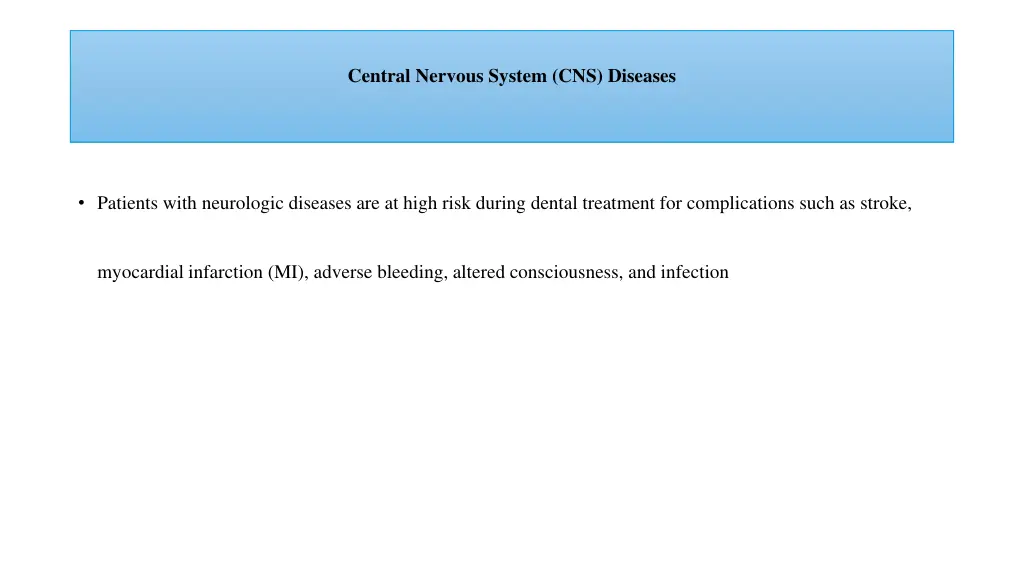
Understanding Epilepsy: Causes, Symptoms, and Classification
Learn about epilepsy, a neurological disorder characterized by seizures, altered consciousness, and involuntary movements. Explore the common causes, classification of epileptic syndromes, different seizure types such as petit mal and grand mal, and the phases of a seizure. Find insights on managing epilepsy for better oral healthcare outcomes.
Download Presentation

Please find below an Image/Link to download the presentation.
The content on the website is provided AS IS for your information and personal use only. It may not be sold, licensed, or shared on other websites without obtaining consent from the author. If you encounter any issues during the download, it is possible that the publisher has removed the file from their server.
You are allowed to download the files provided on this website for personal or commercial use, subject to the condition that they are used lawfully. All files are the property of their respective owners.
The content on the website is provided AS IS for your information and personal use only. It may not be sold, licensed, or shared on other websites without obtaining consent from the author.
E N D
Presentation Transcript
Central Nervous System (CNS) Diseases Patients with neurologic diseases are at high risk during dental treatment for complications such as stroke, myocardial infarction (MI), adverse bleeding, altered consciousness, and infection
Epilepsy Epilepsy is a term that refers to a group of disorders characterized by chronic recurrent, paroxysmal changes in the neurologic function (seizures), altered consciousness, or involuntary movements caused by abnormal and spontaneous electrical activity in the brain
The cause of epilepsy is idiopathic in more than half of all patients. Other causes of fits include: Vascular abnormalities (cerebrovascular disease). Developmental abnormalities (cavernous malformation). Intracranial neoplasms (gliomas). Head trauma. Hypoglycemia Drug withdrawal During the seizure, blood becomes hypoxic and lactic acidosis occurs
Classification of Epileptic Syndromes and Seizure Types Epileptic Syndromes Primary or Idiopathic Secondary or Symptomatic
Seizure Types Partial (Focal, Loca Generalized (Convulsive or Nonconvulsive) l) Unclassified Epileptic Seizures
Petit mal seizures: Most often come during childhood and are characterized by minimal or no movements (except for eye blinking) and an apparently blank stare, and brief sudden loss of awareness or of conscious activity; which may only last seconds. Grand mal (tonic-clonic) epilepsy: Usually begin in childhood, or sometimes at about puberty. There is a warning (aura), followed by loss of consciousness, tonic and clonic convulsions and finally a variably prolonged recovery.
The aura may consist of a mood change, irritability, brief hallucination or headache. After the aura warning, the patient emits a sudden "epileptic cry" (caused by spasm of the diaphragmatic muscles) and immediately loses consciousness The tonic phase Clonic activity status epilepticus
Laboratory findings The diagnosis of epilepsy generally is based on the history of seizures and an abnormal electroencephalogram (EEG). Other diagnostic procedures that are useful for ruling out other causes of seizures include: CT, MRI LUMBER PUNCTURE SERUM CHEMISTRY PROFILES TOXICOLOGY
Medical management Phenytoin (Dilantin), carbamazepine (Tegretol), and valproic acid (Depakene) are considered first line treatments.
Erythromycin should not be administered to patients who are taking carbamazepine because of interference a. with metabolism of carbamazepine, which could lead to toxic levels of anticonvulsant drug. Aspirin and NSAIDs should not be administered to patients who are taking valproic acid because they can b. further decrease platelet aggregation, leading to hemorrhagic episodes. No contraindication has been identified to the use of local anesthetics in proper amounts to these patients. c.
Dental management Identification of patient by history Provision of normal care: Well-controlled seizures pose no management problems If questionable history or poorly controlled seizures, consultation with physician before dental treatment may require modification of medications Possibility of bleeding tendency in patients taking valproic acid (Depakene) or carbamazepine (Tegretol) as the result of platelet interference Pretreatment platelet function analyzer (PFA)-100; if grossly abnormal, consultation with physician
Seizure management Preventive measures include If the patient has a seizure while in the dental chair After the seizure If seizure becomes prolonged or is repeated (status epilepticus):
Stroke Stroke is a generic term that is used to refer to a cerebrovascular accident a serious and often fatal neurologic event caused by sudden interruption of oxygenated blood to the brain
Etiology Ischemic stroke Hemorrhagic stroke
Signs and Symptoms Transient ischemic attack (TIA) Reversible ischemic neurologic deficit (RIND) Stroke-in-evolution Completed stroke
Laboratory Findings urinalysis, blood sugar level, complete blood count, erythrocyte sedimentation rate, serologic tests for syphilis, blood cholesterol and lipid levels, chest radiographs, and electrocardiogram Doppler blood flow, EEG, cerebral angiography, CT, and MRI, are important for determining the extent and location of arterial injury.
Medical management Prevention Stroke Treatment
Dental Management Identify risk factors Encourage control of risk factors (referral to physician, if appropriate) Obtain thorough history of stroke Avoid elective care in patients who have had recent TIAs or RINDs Determine risk for bleeding problems in patients taking anticoagulant drugs, and minimize perioperative bleeding Schedule short, stress-free, midmorning appointments
Monitor blood pressure and oxygen saturation Use minimum amount of anesthetic containing vasoconstrictor Avoid epinephrine in gingival retraction cord Recognize signs and symptoms of a stroke, provide emergency care, and activate emergency medical support system A prior stroke may require assistance for patient transfer to the chair
Oral Manifestations and Complications Patient experiencing a stroke event After stroke
